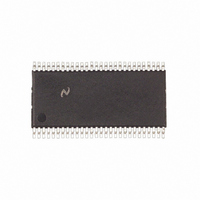COP8SCR9KMT8 National Semiconductor, COP8SCR9KMT8 Datasheet - Page 38

COP8SCR9KMT8
Manufacturer Part Number
COP8SCR9KMT8
Description
IC MCU EEPROM 8BIT 32K 56-TSSOP
Manufacturer
National Semiconductor
Series
COP8™ 8Sr
Datasheet
1.COP8SCR9HVA8NOPB.pdf
(80 pages)
Specifications of COP8SCR9KMT8
Core Processor
COP8
Core Size
8-Bit
Speed
20MHz
Connectivity
Microwire/Plus (SPI), UART/USART
Peripherals
Brown-out Detect/Reset, POR, PWM, WDT
Number Of I /o
49
Program Memory Size
32KB (32K x 8)
Program Memory Type
FLASH
Ram Size
1K x 8
Voltage - Supply (vcc/vdd)
2.7 V ~ 5.5 V
Oscillator Type
Internal
Operating Temperature
-40°C ~ 85°C
Package / Case
56-TSSOP
Lead Free Status / RoHS Status
Contains lead / RoHS non-compliant
Eeprom Size
-
Data Converters
-
Other names
*COP8SCR9KMT8
www.national.com
13.0 Power Saving Features
13.1 POWER SAVE MODE CONTROL REGISTER
The ITMR control register allows for navigation between the
three different modes of operation. It is also used for the Idle
Timer. The register bit assignments are shown below. This
register is cleared to 40 (hex) by Reset as shown below.
LSON:
HSON:
DCEN:
CCKSEL: This bit selects whether the high speed clock or
LSON
Bit 7
HSON
Bit 6
This bit is used to turn-on the low-speed oscilla-
tor. When LSON = 0, the low speed oscillator is
off. When LSON = 1, the low speed oscillator is
on. There is a startup time associated with this
oscillator. See the Oscillator Circuits section.
This bit is used to turn-on the high speed oscil-
lator. When HSON = 0, the high speed oscillator
is off. When HSON = 1, the high speed oscillator
is on. There is a startup time associated with this
oscillator. See the startup time table in the Os-
cillator Circuits section.
This bit selects the clock source for the Idle
Timer. If this bit = 0, then the high speed clock is
the clock source for the Idle Timer. If this bit = 1,
then the low speed clock is the clock source for
the Idle Timer. The low speed oscillator must be
started and stabilized before setting this bit to a
1.
low speed clock is gated to the microcontroller
core. When this bit = 0, the Core clock will be the
high speed clock. When this bit = 1, then the
Core clock will be the low speed clock. Before
switching this bit to either state, the appropriate
clock should be turned on and stabilized.
DCEN
Bit 5
CCK
Bit 4
SEL
RSVD
Bit 3
ITSEL2
Bit 2
FIGURE 19. Diagram of Power Save Modes
ITSEL1
Bit 1
(Continued)
ITSEL0
Bit 0
38
RSVD:
Bits 2–0: These are bits used to control the Idle Timer. See
Table 16 lists the valid contents of the four most significant
bits of the ITMR Register. Any other value is illegal. States
are presented in the only valid sequence. Any attempt to
make a transition to any state other than an adjacent valid
state will be ignored by the logic and the ITMR Register will
not be changed.
DCEN CCKSEL
LSON HSON DCEN CCKSEL
TABLE 16. Valid Contents of Dual Clock Control Bits
0
1
1
0
0
1
1
1
1
This bit is reserved and must be 0.
12.1 TIMER T0 (IDLE TIMER) for the description
of these bits.
0
0
1
1
1
1
1
1
0
High Speed Mode. Core and Idle Timer
Clock = High Speed
Dual Clock Mode. Core clock = High
Speed; Idle Timer = Low Speed
Low Speed Mode. Core and Idle Timer
Clock = Low Speed
Invalid. If this is detected, the Low
Speed Mode will be forced.
0
0
1
1
1
10138922
0
0
0
1
1
High Speed
High Speed/Dual
Clock Transition
Dual Clock
Dual Clock/Low
Speed Transition
Low Speed
Mode










